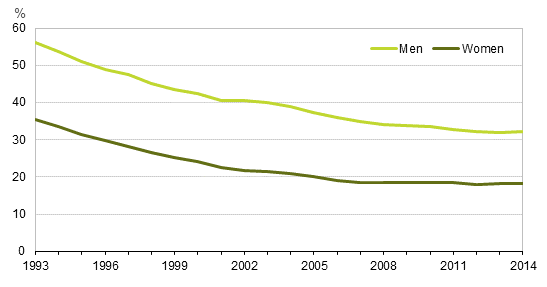Published: 27 November 2015
Young people leave childhood home later
According to Statistics Finland's family statistics, the share of young people aged 20 to 24 living at home has fallen clearly in the past twenty years, but in recent years, the share has evened out to around one-quarter. Young people leaving their childhood home is described by the number of persons aged 20 to 24 with the status of a child in the family. In 2014, the relative share of young people with the status of a child in the age group even grew. The growing share of young people with the status of a child is probably connected to them leaving home later in life and moving back home.
Young people aged 20 to 24 with the status of a child in 1993 to 2014

In 1995, as many as 42 per cent of those aged 20 to 24 had the status of a child, but at the end of 2014, the share was just 25 per cent. Young women become independent and move earlier from their childhood home than young men. Nowadays, nearly one-third of men still live with their parents at the age of 20 to 24, while only 18 per cent of women have the status of a child at that age. Six per cent of men aged 30 have the status of a child in their family, three per cent of women.
In June 1994, an act entered into force entitling everyone to choose their official municipality of residence. The act enabled students to move officially to their location of study. Between 1985 and 1993, even before the entry into force of the Act on the Municipality of Domicile, the share of young people aged 20 to 24 with the status of a child fell from 54 to 46 per cent. After the legislation entered into force, their share diminished even further. Data on the number of persons with the status of a child are not available for all years before 1993. The uniform time series is from 1993 onwards.
Source: Population and Justice Statistics, Statistics Finland
Inquiries: Marjut Pietiläinen 029 551 2798, Timo Nikander 029 551 3250, info@stat.fi
Director in charge: Jari Tarkoma
Publication in pdf-format (811.1 kB)
- Reviews
-
- 1. Average number of family members is 2.8 persons (27.11.2015)
- 2. Four per cent of families entirely foreign-language speaking (27.11.2015)
- 3. Number of families with children goes on falling (27.11.2015)
- 4. Differences between regions in family types - married couple still the most common one (Corrected on 4. December 2015. The corrections are indicated in red) (27.11.2015)
- 5. Eighty-two per cent of children in families with two parents (27.11.2015)
- 6. Share of young people with the status of a child grew slightly (27.11.2015)
- 7. One-fifth are living alone (27.11.2015)
- Tables
-
Tables in databases
Pick the data you need into tables, view the data as graphs, or download the data for your use.
Appendix tables
- Appendix table 1. Family population and average size of family in 1950 - 2014 (27.11.2015)
- Appendix table 2. Swedish-speaking families by type and number of children of spouses/parents December 31, 2014 (27.11.2015)
- Appendix table 3. Married couples by order of marriage of man and woman on December 31, 2014 (27.11.2015)
- Appendix table 4. Families by language of spouses/parents on December 31, 2014 (27.11.2015)
- Appendix table 5. Families with underage children by language of parents on December 31, 2014 (27.11.2015)
- Appendix table 6. Families by citizenship of spouses/parents on December 31, 2014 (27.11.2015)
- Appendix table 7. Families with underage children by citizenship of parents on December 31, 2014 (27.11.2015)
- Appendix table 8. Families by country of birth of spouses/parents on December 31, 2014 (27.11.2015)
- Appendix table 9. Families with underage children by country of birth of parents on December 31, 2014 (27.11.2015)
- Appendix table 10. Families by type of family and number of children aged 17 or under living at home on December 31, 2014 (27.11.2015)
- Appendix table 11. Families with underage children by number of children aged 17 or under and family type on December 31, 2014 (27.11.2015)
- Appendix table 12. Reconstituted families by family composition and number of children on December 31, 2014 (27.11.2015)
- Appendix table 13. Families by age group of children and type of family on December 31, 2014 (27.11.2015)
- Appendix table 14. Children aged 0 - 24 by type of family, adopted children in families by age on December 31, 2014 (27.11.2015)
- Appendix table 15. Children by age and number of children in the family living at home aged 17 or under on December 31, 2014 (27.11.2015)
- Appendix table 16. Men with a family by age and type of family on December 31, 2014 (27.11.2015)
- Appendix table 17. Women with a family by age and type of family on December 31, 2014 (27.11.2015)
- Quality descriptions
-
- Quality description, families 2014 (27.11.2015)
Updated 27.11.2015
Official Statistics of Finland (OSF):
Families [e-publication].
ISSN=1798-3231. Annual Review 2014. Helsinki: Statistics Finland [referred: 12.4.2025].
Access method: http://stat.fi/til/perh/2014/02/perh_2014_02_2015-11-27_tie_001_en.html

